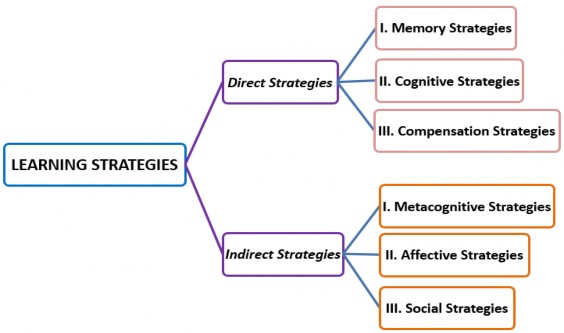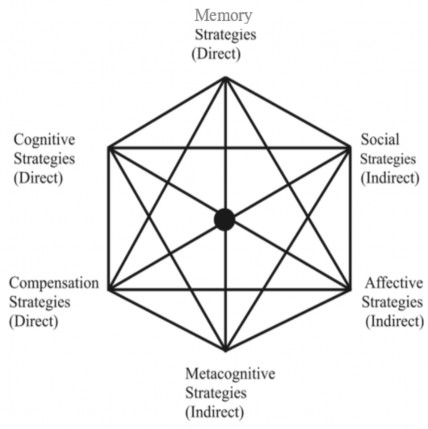Cohen (1998, p.4; cited in Selinker & Susan, 2008, p.439) defined language learning strategies as “processes which are consciously selected by learners and which may result in action taken to enhance the learning or use of a second or foreign language, through their storage, retention, recall, and application of information about that language”.
Chamot (1998, p.2) demonstrated “Learning strategies are the thoughts that students have and actions that they can take to assist their comprehension, recall, production, and management of their language learning”.
Oxford (1990s, 1999, cited in Selinker & Susan, 2008, p.439) refered to learning strategies as “Specific actions, behaviors, steps, or techniques that students use to improve their own progress in developing skills in a second or foreign language”.
Hence, learning strategies have been seen as special ways of information processing that improve comprehension, learning, or retention of the information and problem solving. Learning strategies are essential because they enhance students’ learning and help develop their language communicative competence.
2.1.2. Classification of learning strategies
Many linguists have had classification of learning strategies homogeneously. The developmental process of learners always needs using strategies: Learning Strategies and Communication Strategies. Learning Strategies relating to input (processing, storage, and retrieval), were divided into three such types as Cognitive, Metacognitive, and Socioaffective Strategies (Chamot & Küpper, 1989; O’Malley, Chamot, & Küpper, 1989; O’Malley, Chamot, Stewner-Manzanares, Küpper, & Russo, 1985).
Communication Strategies relating to output (how we express meanings) were just with Avoidance Strategies and Compensatory Strategies. Strategies were defined as to facilitate the learning tasks (Chamot 2005, p.112, cited in Brown, 2000). More descriptions of Learning Strategies can be seen in Appendix 1(Descriptions of Learning Strategies, source: O’Malley's et al., 1985).
However, learning strategies can be grouped in other ways. Figure 2.1. - Learning strategies by Oxford (1990) showed a classification clearly detailed with two main classes: Direct Strategies and Indirect Strategies in which each one included three categories (see Appendix 2for Diagram of the Strategy System showing all the Strategies).
Có thể bạn quan tâm!
-
 The use of language learning strategies in English reading at Doan Ket secondary school - An investigation - 1
The use of language learning strategies in English reading at Doan Ket secondary school - An investigation - 1 -
 The use of language learning strategies in English reading at Doan Ket secondary school - An investigation - 2
The use of language learning strategies in English reading at Doan Ket secondary school - An investigation - 2 -
 The use of language learning strategies in English reading at Doan Ket secondary school - An investigation - 3
The use of language learning strategies in English reading at Doan Ket secondary school - An investigation - 3 -
 Reading Strategy Instructions In Secondary Schools
Reading Strategy Instructions In Secondary Schools -
 The use of language learning strategies in English reading at Doan Ket secondary school - An investigation - 6
The use of language learning strategies in English reading at Doan Ket secondary school - An investigation - 6 -
 The use of language learning strategies in English reading at Doan Ket secondary school - An investigation - 7
The use of language learning strategies in English reading at Doan Ket secondary school - An investigation - 7
Xem toàn bộ 140 trang tài liệu này.

Figure 2.1. Diagram of a strategy system: Overview (Oxford, 1990, p.16)
Direct strategies create the target language to learners while indirect strategies support learners' language learning and use. Direct strategies include memory, cognitive, and compensation strategies; indirect strategies consist of metacognitive, affective, and social strategies. In this study, the researcher will incline to Oxford’s definitions and classification of learning strategies.
Specifically, Oxford’s (1990) classification of learning strategies includes the followings:
⮚ Memory strategies: “Memory strategies or mnemonics with four sets of creating mental linkages, applying images and sounds, reviewing, and employing actions that help learners retain new information”. (p.38)
⮚ Cognitive strategies: “Cognitive strategies which learners manipulate or transform the target language that involve practicing, receiving and sending messages, analyzing and reasoning, and creating structure for input and output”. (p.43)
⮚ Compensation strategies: “Compensation strategies enable learners to comprehend or produce knowledge or the target language. They have two sets of guessing intelligently in receptive skills (listening and reading), and overcoming limitations in productive skills (speaking and writing)”. (p.47)
⮚ Metacognitive strategies: “Metacognitive strategies are which learners can manage their learning, including three sets of centering our learning, arranging and planning our learning, and evaluating our learning”. (p.136)
⮚ Affective strategies: “Affective strategies are the strategies relating to learners' emotions, attitudes, and motivations in language learning. They include three sets of lowering our anxiety, encouraging ourselves, and taking our emotional temperature”. (p.140)
⮚ Social strategies: “Social strategies with the three sets are those involving people and their social communication with three sets of
asking questions, cooperative learning, and empathy and each included two elements inside”. (p.140)
Oxford’ s (1990) classification of learning strategies is depicted pretty specific in the Diagram of a strategy system showing two classes, six groups and 19 sets. To shorten what is included in each type of language learning strategies in this diagram, please see the sub-items thrusted inside Figure 2.2.
Figure 2.2. Diagram of a strategy system showing two classes, six groups and 19 sets (Oxford, 1990, p.17)
Various language learning strategies lead to the different use among students is inevitable, provided that teachers can encourage the learners to complete the specific tasks or any learning situation easily in their language learning processes. Oxford’s model has an appearance of a regular polygon with the multangulars and interlacements themselves that seems to have a representation for its strengths and weaknesses. This model shows the interrelationships between direct and indirect strategies among the six strategy groups shows that Direct Strategies and Indirect Strategies always support each other and it is sure that the conflicts often happens the classification of learning strategies (see Figure 2.3.).

Figure 2.3. Inter-relationships between direct and indirect strategies among the six strategy groups (Oxford 1990, p.15)
2.1.3. The factors related to learning strategies
Many arguable ideas about factors affecting language learning strategies worldwide. Rubin (1975) soon stated that “a good language learner is a willing
and accurate guesser”. This person must grasp essential skills through three variables: aptitude, motivation, and opportunities. Teachers are those who give appropriate methods promoting the student's incorporative learning strategies and help recognize their FLA. The general model from Spolsky (1989) about second language learning was given in details that a language perspective starting from the social context leads to attitude, and motivation. According to Mohammad Rahimi (2008), “learners’ language learning strategies are affected by the level of language proficiency, motivation, learning style and gender strong effect on learners’ use of different types of strategies”. Salma Binti Abdul Razak (2014) also stated the influential factors such as Motivation, Gender, Levels of English proficiency, Age, and Socioeconomic status.
Besides that, a number of factors influence language learning strategies into cognitive processes like “individual factors, learners’ belief, and affective factors” (Ellis, 1997). Most remarkably, individual factors include age, personality, motivation, experiences, cognition, and native language as every person has one’s own hobby, personality and learning target. Learners need the elements of autonomy, the experimental learning and centeredness during their learning process. Learner autonomy is the right of a learner to be independent and governs itself. It allows learners to do everything for a production or a success, to initiate, to finish, to solve problems or to practice language use every time and everywhere they want (Brown, 2000). Learners’ belief, and affective factors mixed among the practical values of their lives under a variety of criteria. Experimental learning means taking learners' immediate personal experience as a departure point and its nature of process is “learning by doing”. Richards & Rodgers (2001) indicated that language learning aims to achieve meaningful communication and even help reinforce the second language acquisition (SLA). Learner centeredness links strongly
with communicative language teaching, and a key difference here depends on information about learners or students, learners must be trained in the learning strategies and the specialized fields they need for occupations and languages.
Next, teachers' roles in strategy training are the foremost factor that influences students’ learning consciousness. Teachers are learning facilitators with new roles and beliefs (Oxford 1990) as a language instruction for primary schools. Traditionally, teachers should ensure teaching qualifications for the roles as instructor, facilitator, observer, coordinator, etc. (Brown, 2001). Moreover, new roles for teachers are not on any authority more, but on the quality (i.e. providing more opportunities for student's practice) and good relationship with learners. Planning, assessing, and teaching, planning lessons, class observation, motivation for students, and classroom management are considerable ones in “shaping good teaching practice” (Crookes, 2003). Thus, teachers’ roles somehow indirectly affect a student's language learning strategies - promoting student's good insights.
Finally, many other factors like problem orientation, action basis, involvement beyond just cognition, direct and indirect support learning, degree of observability, level of consciousness, teachability, flexibility, and influences on strategy choice are important ones of language learning strategies (Oxford, 1990). Though there is a close relationship between one's language learning style and preferred language learning strategies, LLS are different from learning styles in which refer to a learner's “natural, habitual, and preferred way(s) of absorbing, processing, and retaining new information and skills” (Reid 1995, p.89). The bilingual children want to be good at reading strategies, they must stand steady for orthographic and cognitive factors to develop the basic reading skills of first language (L1) and second language (L2) because reading is a complex skill. There is “a correlation between the basic reading
skills in L1 and L2, and children’s performance is under the cognitive factor”
– the working memory in different languages means the word-based reading processes vary the orthographic regularity (Gholamain & Geva, 1999).
2.2. Significance of English reading strategy use at secondary schools
2.2.1. Relevance of reading selection in English learning
In consideration with language skills, reading is one of the two language receptive skills, especially to the core force of Secondary Education. Koda (2005) has analyzed fluent reading accomplished largely by word recognition, a large vocabulary, knowledge of text structure and discourse organization. L1 reading processes influence on L2 reading development.
As Pressley & Afflerbach (1995) have shown, good readers engage in a number of strategic activities at every stage (before, during, and after reading), and then they may facilitate comprehension most. Reading the texts is also a challenge in making a completely comprehensive meaning.
Traditionally, reading skill is recognized under such forms as previewing, skimming, scanning, selective reading, and activating prior knowledge. Now, reading becomes more diversified with intensive reading, extensive reading and readers can skip over any strange or difficult words but still master the text’s meaning.
Thus, lower secondary school students should be intensified reading skills first. Teachers will train students LLS via in-class reading activities with the designed multiple tasks. Relevance of reading skill selection in English language learning here is that the two-purpose accomplishment: focusing readers’ attention on the texts or reading process, and making students’ interactions with the text or easy assessing their performance.






